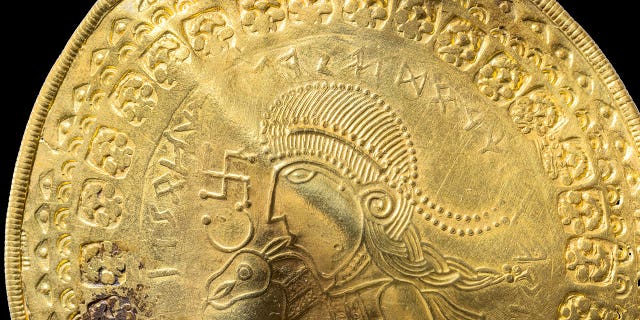Scandinavian scientists said on Wednesday they had identified the oldest known inscription referencing the Norse god Odin on part of a gold disc found in western Denmark in 2020.
Lisbeth Imer, a runologist at the National Museum in Copenhagen, said the inscription represents the first concrete evidence of Odin worship as early as the 5th century, at least 150 years before the earliest known earlier reference, which was on a brooch found in Copenhagen. Southern Germany and dated to the second half of the 6th century.
The disc discovered in Denmark was part of a hoard containing about 2.2 pounds of gold, including large medallions the size of saucers and Roman coins turned into jewels. It was unearthed in the village of Vindelev in central Jutland and nicknamed the Vindelev Hoard.
ARCHAEOLOGISTS IN EGYPT DISCOVER ROMAN-ERA SPHINX-LIKE STATUE
Experts think the cache was buried 1,500 years ago, either to hide it from enemies or as a tribute to appease the gods. A gold bracteate – a kind of thin ornamental pendant – bore an inscription that read: “he IS Odin’s man”, probably referring to an unknown king or lord.
“It’s one of the best-executed runic inscriptions I’ve ever seen,” Imer said. Runes are symbols that early northern European tribes used to communicate in writing.

The inscription “He is Odin’s man” is seen above the head of a figure on a gold bract found in Vindelev, Denmark in late 2020. (Arnold Mikkelsen, The National Museum of Denmark via AP)
Odin was a major god in Norse mythology and was often associated with warfare and poetry.
More than 1,000 bracteates have been found in northern Europe, according to the National Museum in Copenhagen, where the find discovered in 2020 is on display.
Krister Vasshus, a specialist in ancient languages, said that because runic inscriptions are rare, “each runic inscription (is) vital to how we understand the past.”
ROMAN SANCTUARY DISCOVERED UNDER FORMER CATHEDRAL CEMETERY IN ENGLAND
“When an inscription of this length appears, that in itself is astonishing,” Vasshus said. “It gives us some pretty interesting information about past religion, which also tells us something about past society.”
During the Viking Age, considered to be from 793 to 1066, the Norse people known as Vikings undertook large-scale raiding, colonization, conquest, and trade across Europe. They also reached North America.
CLICK HERE TO GET THE FOX NEWS APP
The Norse worshiped many gods and each of them had various characteristics, weaknesses and attributes. Based on sagas and some runestones, details emerged that the gods possessed many human traits and could behave like humans.
“This kind of mythology can take us further and make us re-examine all the other 200 bracteate inscriptions that we know of,” Imer said.
